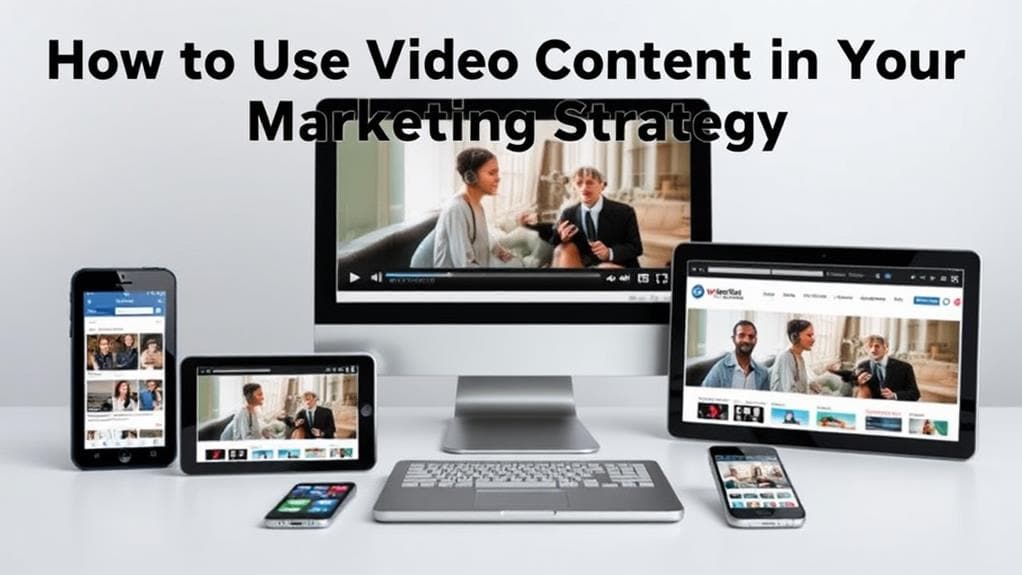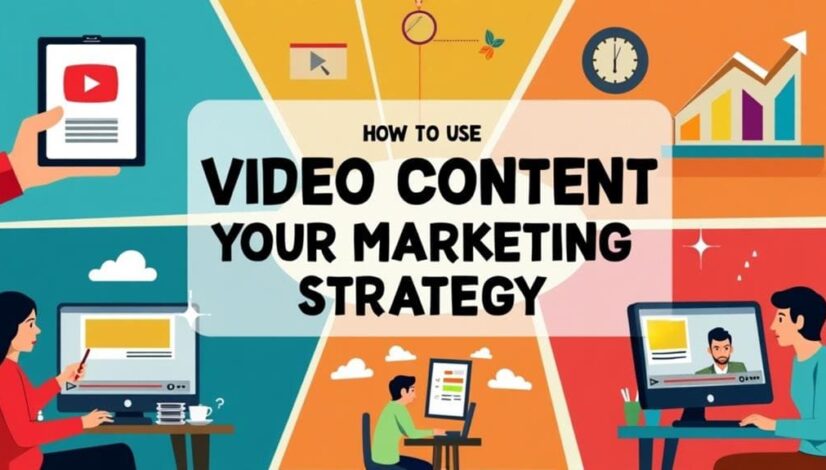How to Use Video Content in Your Marketing Strategy
To effectively use video content in your marketing strategy, first identify the types of videos that resonate with your audience, such as explainer videos, testimonials, or product demos. Understand your target demographics to tailor content that aligns with their preferences. Integrate videos across various platforms, ensuring consistent branding and adapting to each channel's strengths. Monitor engagement metrics to assess performance and refine strategies accordingly. Additionally, prioritize high production quality and engaging scripts to maximize viewer retention. By employing these strategies, you can enhance your marketing efforts and drive better results in engaging your audience. There's more to explore on optimizing your approach.
Key Takeaways
- Identify your target audience through demographic analysis and tailor video content to their preferences for improved engagement and relevance.
- Utilize various video types like explainer videos, product demos, and testimonial clips to effectively communicate your brand message and build trust.
- Implement cross-promotion strategies by sharing videos across multiple platforms, enhancing visibility, and driving traffic between your channels.
- Monitor viewer engagement metrics and A/B test different video elements to refine your strategies and enhance overall performance.
- Maintain consistent branding in your videos to reinforce brand identity and build audience trust through cohesive messaging and visuals.
Understanding Video Content Types

In the field of marketing, understanding the various types of video content is essential for developing effective strategies that resonate with target audiences. Different formats of video serve distinct purposes and can greatly enhance brand communication and engagement.
Among the most popular types are explainer videos, which simplify complex concepts and educate viewers about products or services. These videos are instrumental in fostering a transparent brand image and building trust.
Testimonial clips provide genuine endorsements from satisfied customers, further establishing credibility and social proof. Product demos showcase functionality and usability, making this type of content invaluable for guiding potential customers through their purchasing journey.
Animated shorts offer a creative avenue for storytelling, effectively capturing attention and sparking interest in brand narratives. Additionally, live streaming has emerged as a dynamic way to interact with audiences in real-time, offering a sense of immediacy that pre-recorded content often lacks.
Video ads effectively promote products and services across various platforms, while social media stories provide a fleeting yet impactful way to connect with followers on a personal level.
Behind the scenes content can humanize a brand, granting viewers a glimpse into the operational aspects and culture of the organization, thereby cultivating deeper emotional connections.
Ultimately, leveraging these diverse video content types strategically can empower marketers to forge meaningful relationships with their audiences, enhancing brand loyalty and driving business success.
Identifying Your Target Audience
Understanding the nuances of your target audience is essential, as it directly influences the effectiveness of video content in marketing strategies. To craft compelling videos, marketers must engage in thorough demographic analysis, identifying significant characteristics such as age, gender, location, and income. This foundational data facilitates audience segmentation, allowing for tailored content that resonates with specific group interests.
Audience segmentation not only enhances the relevance of video content but also aligns with viewer preferences and engagement habits. Analyzing how different demographics interact with various types of video—be it educational, entertainment, or inspirational—reveals important insights into content interests. For instance, millennials may favor short, snappy videos shared on social media, while older audiences might gravitate toward in-depth tutorials on platforms like YouTube.
Moreover, understanding platform usage is essential. Different segments prefer distinct platforms, influencing where your video content should be deployed. A well-researched approach will determine whether your audience engages more with Instagram Reels or Facebook Live sessions, enhancing the likelihood of connection.
Integrating Video Across Platforms

Leveraging video content across multiple platforms is a strategic imperative for marketers aiming to maximize reach and engagement. A well-crafted video strategy includes careful video platform selection and effective cross-channel promotion to guarantee your message resonates widely and compels action.
To accomplish this integration seamlessly, consider the following strategies:
- Tailor Content to Each Platform: Recognize that different platforms cater to distinct audiences and content types. Adapt your video content to fit the unique tone and style of each platform—what works on Instagram may not resonate on LinkedIn.
- Utilize Cross-Promotion Techniques: Drive traffic between platforms by promoting your videos on multiple channels. For instance, share clips on Instagram Stories linking back to full videos on YouTube or host live discussions on Facebook to engage with your audience.
- Guarantee Consistent Branding: Maintain a cohesive brand identity across all video content. Use the same colors, logos, and messaging styles to reinforce recognition and trust with your audience.
- Leverage Analytics to Refine Strategy: Monitor viewer engagement and platform performance to identify what resonates most with your audience. Use these insights to refine your video platform selection and optimize future content strategies.
Measuring Video Performance
Effective video marketing hinges on the ability to measure performance accurately. To truly harness the power of video content, marketers must deploy relevant video analytics tools that provide extensive insight into how videos are performing. Monitoring viewer engagement metrics such as watch time, drop-off rates, and interaction levels is essential in evaluating content effectiveness.
These metrics reveal the extent to which audiences engage with the video, informing content creators whether their strategies resonate or need recalibration. For instance, high watch times may indicate engaging content, while significant drop-off points can highlight specific areas where viewer interest wanes. Such insights empower marketers to refine their approach, crafting videos that enchant and retain the audience's gaze.
Moreover, it's vital to segment viewer data by demographics and behaviors, as different audiences may exhibit diverse engagement patterns. Understanding these distinctions allows for targeted marketing efforts that resonate profoundly with specific segments.
Combining qualitative feedback with quantitative data from video analytics tools also enhances the ability to tailor video content dynamically, ensuring it aligns with viewer preferences.
Additionally, utilizing A/B testing can help in identifying the elements that drive higher engagement rates, such as varied calls to action, different video lengths, or specific visual elements.
Best Practices for Video Production

Crafting compelling video content requires a strategic blend of creativity and technical expertise, with a focus on best practices that elevate production quality. By adhering to proven standards, marketers can effectively capture their audience's attention while communicating their brand message clearly and effectively.
Here are four fundamental best practices for video production:
- Scriptwriting Techniques: Effective storytelling begins with strong scriptwriting. Develop a script that outlines your key messages, ensuring it aligns with your audience's interests. Focus on a compelling hook in the introduction, maintain clarity, and conclude with a strong call to action.
- Quality Filming Equipment: Invest in high-quality filming equipment. Whether you use a professional camera or a smartphone, prioritize good lighting, sound quality, and stabilization to improve the overall production value. Remember, mediocre visuals can detract from even the best script.
- Engagement Strategies: Utilize various engagement strategies such as interactive elements, graphics, or animations to make your video more appealing. Engaging viewers from the outset holds their attention and increases retention.
- Post-Production Excellence: Post-production is vital for refining your video. Pay attention to editing, color correction, and sound mixing. Make sure your final cut flows smoothly and reflects the professionalism of your brand.
Frequently Asked Questions
What Is the Ideal Video Length for Different Platforms?
Determining the ideal video length necessitates an understanding of platform preferences and audience engagement.
For instance, TikTok and Instagram Reels favor brevity, with preferred lengths around 15 to 60 seconds, maximizing viewer retention.
In contrast, platforms like YouTube allow for longer formats, ideally 7 to 15 minutes, enabling deeper storytelling.
Tailoring content length to suit specific platforms enhances viewer satisfaction, fostering stronger connections and increasing the likelihood of audience interaction and loyalty across channels.
How Do I Optimize Video SEO for Better Visibility?
Optimizing video SEO for better visibility necessitates a strategic approach. Start by incorporating relevant video keywords into titles, descriptions, and tags to enhance search engine rankings.
Thumbnail optimization is equally essential; a visually compelling thumbnail can greatly improve click-through rates. Additionally, consider implementing structured data markup to help search engines understand your content better.
Consistently monitoring performance metrics will allow for ongoing refinements, empowering your content to reach a broader audience effectively.
Should I Use Animated Videos or Live-Action?
When considering whether to utilize animated videos or live-action content, it is crucial to weigh their respective advantages.
Animated videos offer unique creative freedom, allowing for imaginative storytelling and complex ideas to be conveyed effectively, while also appealing to diverse demographics.
In contrast, live-action videos tend to create a more relatable, personal connection with the audience, leveraging human emotions.
The decision should ultimately align with your campaign goals and target audience preferences for maximum impact.
How Can I Repurpose Existing Content Into Video?
Isn't it ironic that in our fast-paced digital world, existing content often sits neglected, yearning for revival?
Repurposing this content into video can breathe new life into it. Employ various content formats such as infographics or blogs, transforming them into compelling visual narratives.
Use storytelling techniques to engage the audience emotionally, creating videos that resonate deeply. This strategic approach not only amplifies reach but also liberates your ideas, allowing them to flourish in new dimensions.
What Budget Should I Allocate for Video Marketing?
When establishing a budget for video marketing, consider factors such as video production quality, distribution channels, and length of the content.
Budget considerations should encompass pre-production costs, equipment rentals, and post-production editing.
Allocate funds for promotional efforts to maximize reach.
A strategic approach involves analyzing past performance metrics to identify effective formats and audience engagement, ensuring your investment enhances brand visibility while allowing creative freedom in content creation.
Conclusion
To summarize, the integration of video content into a marketing strategy presents a multifaceted opportunity for brands to engage audiences effectively. By understanding various video formats, identifying target demographics, and measuring performance rigorously, businesses can craft campaigns that resonate. Employing best practices in production further enhances the quality and impact of video assets. Ultimately, in the vast ocean of digital marketing, well-executed video content serves as a lighthouse, guiding audiences toward meaningful connections with brands.




